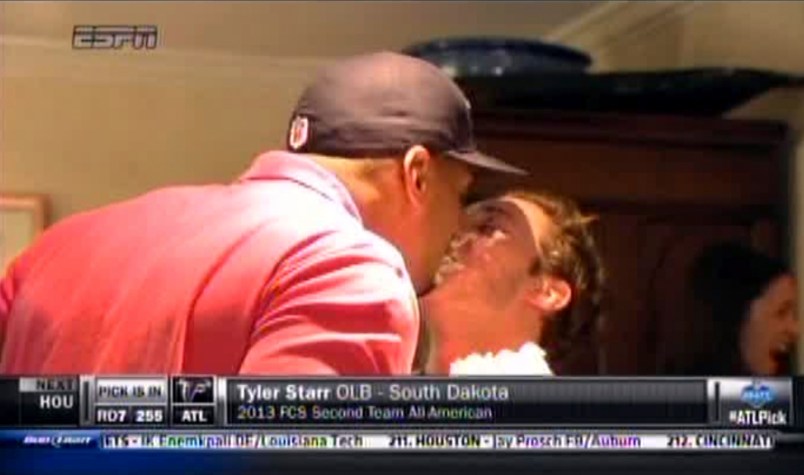In an act of unadulterated joy, Michael Sam and his boyfriend, Vito Cammisano, shared a kiss that has since eclipsed the actual reason for their celebration: The NFL’s St. Louis Rams drafting Sam, effectively making him the league’s first openly gay player.
Reaction to the kiss can be summed up in three words: shock, awe, and, for some, dismay. That it took an unsigned college football player, a few basketball players (NBA’s Jason Collins and WNBA’s Brittney Griner), and a kiss to show that there are black LGBTs who falsify existing stereotypes of the effeminate gay and the masculine lesbian athlete should be the true shock.
The reason for all the hubbub is that Michael Sam’s athletic success, his sport of choice, and his kiss shatter common assumptions about LGBT Americans.
In my research on the lived experiences of urban black gay and lesbian Americans, I have found this point especially key. While many black gay men identify strongly with a racial identity over their sexual orientation, others, like Sam, resist this hierarchy.
Like Sam, my respondents have asserted that being a black gay man is a fused identity whereby race and sexual orientation intertwine. Race and sexual orientation mutually constrain and inform the lives of black gay men and black lesbians. Alongside NBA’s Collins and WNBA’s Griner, Sam’s public discussion of himself as both black and gay has brought this complex reality to new heights of visibility.
The visibility of black gay and lesbian athletes has benefits. By coming out publicly and framing himself as both black and gay, Sam is forcing American sports to come to grips with new ways of understanding and managing the multiple identities of professional athletes.

While there is a way to go, this is a story of progress. In previous generations, gay professional athletes often operated within a specter of invisibility to avoid the peering eyes of colleagues and the public and the possible loss of their livelihood. As was the case for tennis great Billie Jean King, in the past gay athletes were forced out of the ‘closet,’ compelled to come out due to mounting evidence and threats of public exposure of their same sex desires from former lovers.
Unlike many of his predecessors, Sam’s approach has been preemptive and proactive. He told us who is and who he dates before it was clear he would even be a professional athlete. In the process, Sam’s refusal to be an invisible man has offered a tangible example of avoiding the fear and shame that still compels too many to remain quiet and afraid of forced disclosure. By bravely conveying his identity and life on his own terms, Sam is also helping to diminish the bigoted stereotype of the black gay man as a ‘down-low’ untrustworthy sexual fraud.
Sam’s visibility will also surely have costs, some of which we have glimpsed in the dust up over the kiss. Will he be treated as gay? As black? Will his interracial relationship lead others to question his blackness or racial loyalty — as has been the case for his black heterosexual peers?

The answers to these questions will unfold in the years to come and perhaps alongside the coming out stories of future athletes emboldened by Sam, Collins and Griner. Like Jackie Robinson before him, Sam has to manage the consequences of being visible and understood as a proxy for many others. Like many black LGBT Americans, Sam is likely finding that not only do people think they know him, but also now feel they know too much.
While Sam is the first openly gay NFL player, he is not the first gay NFL player (see HBO’s ‘Real Sports’ coverage of Esera Tuaolo). It is my hope that Sam is just the tip of an iceberg of change whereby this new brand of visibility helps give voice and attention to the many other LGBT Americans whose hopes and dreams are dashed for fear of a backlash.
Sam’s example brings to mind a key passage in the Ralph Ellison classic The Invisible Man:
I am invisible, understand, simply because people refuse to see me. Like the bodiless heads you see sometimes in circus sideshows, it is as though I have been surrounded by mirrors of hard, distorting glass. When they approach me they see only my surroundings, themselves or figments of their imagination, indeed, everything and anything except me.
Sam’s choice to go visible is powerful — not just the “kiss tweeted round the world,” but the totality of Sam’s public profile — is helping Americans see the rich diversity that constitutes the black gay and lesbian population.
Marcus Hunter is an assistant professor of sociology at Yale University and a member of the Scholars Strategy Network.







Only thing I take from it is: Even gay black athlete seem to end up with white partners.
My one gay black friend is in a long term relationship with a white guy.
That’s not true. I’m not with someone White.
A kiss is just a kiss…unless it’s a Hershey’s Kiss!